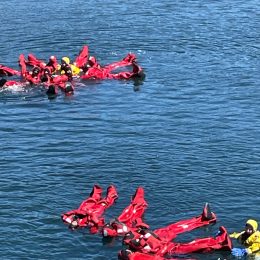Commercial fishing has always been an inherently dangerous occupation; in 1984 the industry was in crisis. A rash of North Pacific capsizings and sinkings – with substantial loss of life – had everyone from government officials to insurance company executives wondering aloud about the future of the fishing industry.
Faced with the prospect of controls designed and enforced by the government that might not necessarily fit the industry, or that might be weakened or stalled by the government regulatory process, coupled with concerns about the cost and availability of insurance, the North Pacific Fishing Vessel Owners’ Association developed a voluntary safety training program, the Vessel Safety Program.
Recognizing the importance of vessel safety standards and crew safety awareness and training, but lacking the authority to regulate the commercial fishing industry, the Coast Guard was also beginning to develop a unique voluntary safety program in 1984.
When the Coast Guard learned that the NPFVOA had already embarked upon a safety program for its fishermen, it joined efforts. This union produced a set of comprehensive “voluntary” standards aimed at vessel safety and personnel/operational safety awareness and education. Neither organization wanted to wait any longer to establish acceptable safety practices to improve the poor safety record and impact the availability of insurance.
Both NPFVOA and the Coast Guard shared the philosophy that legislating safety in the fishing industry took the responsibility away from fishermen. They believed it took commitment from the skipper and crew to maintain a safe operation. Both also desired a program that would appeal to the sensibilities of fishermen, who were waking up to the senselessness of the many tragic losses.
Together, NPFVOA and the Coast Guard produced the Vessel Safety Manual in 1985 (still available from NPFVOA and now in its fifth edition and sixth printing). A core safety program and set of safety training videos followed. The core training program consisted of survival at sea, first aid and CPR, firefighting, and stability/navigation training. The Safety at Sea Video Series (four videos titled Safety Equipment and Survival Procedures, Fire Prevention and Control, Medical Emergencies at Sea, and Fishing Vessel Stability) were designed to complement the training courses or act as refresher training.
Once Congress passed the Commercial Fishing Vessel Safety Act in 1988, which mandated safety equipment and emergency drill training, NPFVOA developed a course to teach individuals how to conduct their emergency drills – the Drill Instructor Workshop.
Since then, NPFVOA has strived to facilitate a high level of safety awareness in the North Pacific fishing fleets. As a non-profit, membership-based organization, NPFVOA works closely with regulatory agencies such as the Coast Guard and OSHA (Occupational Safety and Health Administration), and keeps its members apprised of issues important to the safety of their crews and vessels.
After more than 39 years of providing safety awareness and education to over 55,000 members of the commercial fishing industry and other mariners, NPFVOA continues to develop programs that meet its evolving demands. As the commercial fishing industry continues to evolve and the regulations become more sophisticated and complex, NPFVOA will continue to be on the forefront of safety training technology and development.
